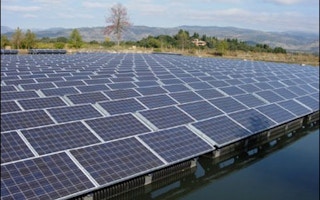Singapore will build its first floating solar system – the first of its kind in the region – in the calm waters of the western Tengeh Reservoir.
The innovative project, led by the Economic Development Board (EDB) and national water agency PUB, will cost $11 million and be operational by 2013.
National Environment Agency (NEA) chief executive Andrew Tan announced this yesterday, noting that the pilot project will be studied for the potential of using reservoir water surfaces for these systems to generate electricity.
This is to overcome Singapore’s land constraints: Solar panels need large land mass to generate a large amount of energy. In Singapore, they are usually built on rooftops.
Speaking at the third Solar Pioneer Awards ceremony, where he was the guest of honour, Mr Tan said he was optimistic that ‘local solar adoption will continue to proliferate, driven by factors such as increased local capabilities, innovation and government support’.
The 2-megawatt solar photovoltaic system – which will be connected to the national grid – will generate enough energy from the sun to power 450 four-room flats at any one time.
Mr Goh Chee Kiong, EDB’s director of clean technology, told The Straits Times: ‘This is a major step for us… if this pilot project works out, the potential is tremendous for rolling out similar projects across the island.’
He added that remote reservoirs would be good locations. Those that currently host recreational activities, such as MacRitchie, will not be considered.
Singapore got its inspiration from existing floating projects such as those in the United States’ Napa Valley, where land owners built such systems to reduce water loss and overcome land constraints, he added.
Singapore’s solar industry has grown into a thriving industry in recent years; The HDB recently unveiled the first solar leasing project, which allowed private firms to design, install and maintain solar energy systems.
The floating project will be a public and private partnership, where the government agencies will work with interested private-sector companies to build the system.
Singapore can learn about the technical challenges and cost-effectiveness of such systems through this test bed, which will also look into other considerations such as aesthetics and impact on the environment, said Mr Goh.
EDB and PUB will also study other potential benefits, such as the cooling effect of the water body on the solar panels, which will enable it to be more effective in generating electricity.
Other possible benefits are reduced water evaporation, and algal growth in the reservoirs.
Industry players said they were excited about the project. Mr Christophe Inglin, managing director of solar firm Phoenix Solar, who is keen to bid for it, said: ‘This is a very interesting experiment… but there are some technical challenges to be ironed out. Water and electricity do not mix very well together.’
NEA’s Mr Tan noted the Asian sunbelt region is viewed as the ‘next exciting growth frontier for solar markets’. ‘Solar energy also has the potential to help Singapore diversify its energy sources and reduce its carbon footprint,’ he said.
Yesterday’s ceremony was held at the inaugural PV Asia-Pacific Expo, part of the annual Singapore International Energy Week.
Five private-sector projects were given the Solar Pioneer Award, which recognises solar installations in Singapore that are at the forefront of system design, size and installation techniques.
The five are Keppel DHCS’ district cooling systems plant at Changi Business Park, Hyflux’s innovation centre in Bendemeer, GlaxoSmithKline Biologicals’ plant in Tuas, OUB Centre’s One Raffles Place Tower 2 and UOL Group’s Upper Pickering hotel and office development.
This article was originally published in The Straits Times.










